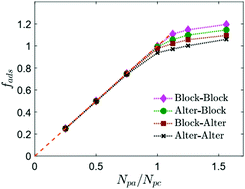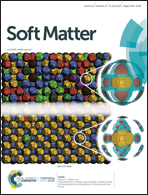Influence of charge sequence on the adsorption of polyelectrolytes to oppositely-charged polyelectrolyte brushes†
Abstract
When a solution of polyanionic chains is placed in contact with a polycationic brush, the polyanions adsorb into the brush. We investigate the influence of the charge sequences of the free and bound species on the thermodynamics of polyelectrolyte adsorption. As model systems, we consider free and brush polyelectrolytes with either block or alternating charge sequences, and study the adsorption process using coarse-grained Langevin dynamics with implicit solvent, explicit counterions, and excess salt. Free energy, internal energy, and entropy of adsorption are computed using umbrella sampling methods. When the number of polyanions exceed the number of polycations, the brush becomes overcharged. Free chains adsorb most strongly when both free and tethered chains have a block charge sequence, and most weakly when both species have an alternating sequence. Adsorption is stronger when the free polyanion has a block sequence and the tethered polycation is alternating than in the reverse case of an alternating free polymer and a tethered block copolymer. Sequence-dependent effects are shown to be largely energetic, rather than entropic, in origin.



 Please wait while we load your content...
Please wait while we load your content...
